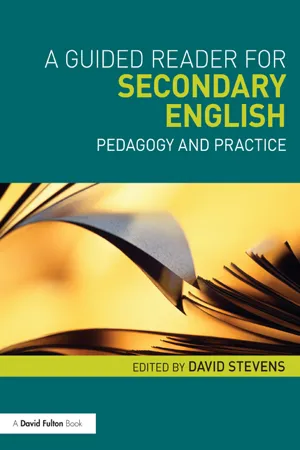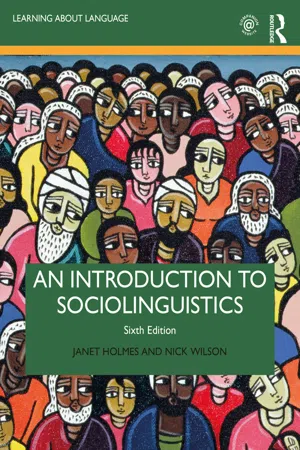Languages & Linguistics
Diction
Diction refers to the choice and use of words in speech or writing. It encompasses the style, clarity, and effectiveness of language, and can convey the tone and mood of a piece of writing. Diction plays a crucial role in shaping the overall impact and meaning of communication.
Written by Perlego with AI-assistance
3 Key excerpts on "Diction"
Learn about this page
Index pages curate the most relevant extracts from our library of academic textbooks. They’ve been created using an in-house natural language model (NLM), each adding context and meaning to key research topics.
- eBook - ePub
A Guided Reader for Secondary English
Pedagogy and practice
- David Stevens(Author)
- 2012(Publication Date)
- Routledge(Publisher)
In the face of conservative appeals for legislation to force the ‘education establishment’ to teach traditional values, including a narrow and exclusive vision of grammar and Standard English (the subjects English and history were, arguably, the most contentious and controversial in this context), linguists and teachers called for rather different approaches. Bill Mittins, for instance, entitled his influential booklet, excerpted from here, Not the Naming of Parts, in opposition to the purely analytical teaching of language, separated from its contexts of actual use. He argued instead for a genuinely creative synthesis of approaches, dispelling widely held myths concerning the nature of language while so doing. Similar critiques may be found in the work of David Allen and Katharine Perera, celebrating language diversity and its inherently fascinating qualities. More recently, Debra Myhill reminds us powerfully that the debates are still very much ‘live’; indeed their relevance to current English classrooms is today even more urgent than it was two decades ago. Extract 1.1 Language is the creation and communication of meaning. Through language we remember the past, experience the present, and predict and plan the future. We experience the lives of others through language and give them accounts of our own. Through literature we extend these encounters so that we learn, and convey to others, lives, events and feelings beyond the limits of our daily world. Our own use of language is the nearest representation of ourselves that we commonly have. By their reaction to our words, others can hurt or heal us, foster or diminish us. Language gives us the ability to acquire knowledge, solve problems and give meaning to our existence. It forms an essential part of the process by which societies are formed and perpetuated. Individuals learn meanings from social situations in which they take part. Ultimately they pass on these meanings to others - eBook - ePub
- Janet Holmes, Nick Wilson(Authors)
- 2022(Publication Date)
- Routledge(Publisher)
Definition: Anxiety or lack of confidence about “correct” or standard linguistic usage, especially in formal situations. People sometimes hypercorrect or over-extend a particular usage when they are unsure of themselves.Example: Latin-based English grammars used by schoolteachers in an earlier era resulted in linguistic insecurity about when it is appropriate to use I vs. me in utterances such as It is I/me.Linguistic landscape
Definition: The language used in public texts. Often a rich source of information about the sociolinguistic complexities of a community. Example: Language used in restaurant signs, shop signs, church signs or advertisements, graffiti, posters, etc.Linguistic relativity
Definition: Weaker form of the Sapir–Whorf hypothesis, stating that language influences our perception, attitudes and thoughts, and potentially affects our behaviour.Example: Many languages have a rich array of terms to describe natural phenomena. French, for example, distinguishes between rivière, a river that flows into another river, as opposed to fleuve, a river that runs directly to the sea.Linguistic (speech) variable
Definition: Linguistic feature with more than one realisation (or variant).Example: Pronunciation of the consonant in -ing as either a velar nasal [ŋ] or as an alveolar nasal [n] at the end of words such as running, hopping; pronunciation of t as either [t] or as a glottal stop between two vowels in words such as butter, matter.Loan words
Definition: Words that have been adopted or borrowed by one language from another.Example: Marae = traditional meeting place (from Māori into New Zealand English); and déjà vu (from French into English).Low (L) diglossic variety
Definition: In a diglossia, the variety used as a colloquial means of everyday communication, and especially in the home. Example: Haitian Creole in Haiti; Swiss German in Switzerland; and Guaraní in Paraguay.Maˉori English
Definition: A variety of New Zealand English often associated with Māori speakers but also used by some non-Māori people with Māori networks.Example: Variety used by Billy T. James playing the newsreader in the YouTube excerpt Te News and character in the New Zealand film Came a Hot Friday. Also the variety used by Taika Waititi in the film Boy. - eBook - ePub
- Gerard Van Herk(Author)
- 2012(Publication Date)
- Wiley-Blackwell(Publisher)
And sometimes, languages are “invisible.” Kachru and Bhatia (1978) describe a situation in parts of India where the local variety (distinct enough for linguists to consider it as a separate language) might not be considered a language at all. So when census takers come around and ask people what language they speak, people instead name the language that they occasionally use in formal situations: Hindi. This was especially true just after Indian independence, when nationalist feeling was at its strongest; in that census, reported Hindi use spiked.Other naming issues: Dialect, slang, accent, variety …This might be a good place to clear up a couple of other naming problems related to dialects. Non-linguists often call non-standard varieties slang . To us linguists, however, “slang” refers only to words – either words that are new to the language, or old words or phrases with new meanings. Slang is usually associated with younger speakers – in fact, a good indicator that a slang term is finished is when middle-aged university professors like me start using it. Most slang is “faddish” or short-lived – you don’t hear many people saying far out or the bee’s knees any more, and if I put any current slang in the book, it’ll be outdated by the time you read it. Not all slang dies out, though. Mob , freshman , and glib all started out as slang, but have become part of the standard language, and only a generation ago mainstream news media used to give a definition whenever they used the then-obscure slang term ripoff . Unlike slang, a dialect is usually distinct in multiple linguistic domains – lexicon (word choice), morphology (word structure), syntax (sentence structure), and phonology/phonetics (pronunciation).A second term sometimes used by non-linguists to describe dialects is accent


